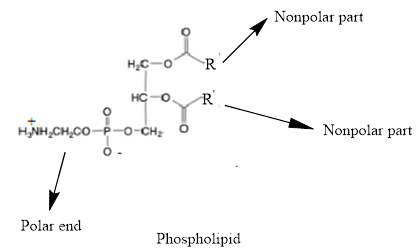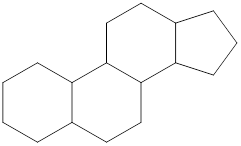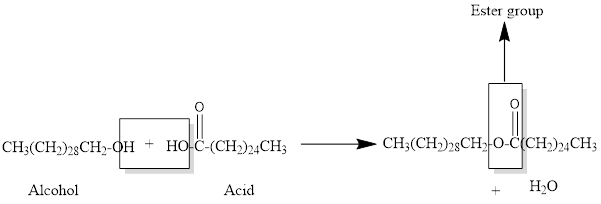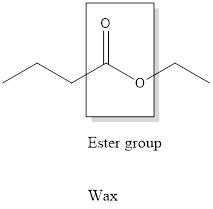
Interpretation:
The structures of a steroid, a phospholipid and a wax should be compared and contrast.
Concept introduction:
The molecules which contains hydrocarbons and not soluble in water but soluble in nonpolar solvents is known as lipid.
Lipids are classified as:
Triglycerides, Phospholipids and, Steroids and Waxes
Explanation of Solution
General structure of phospholipids contains a glycerol molecule(s), phosphate group and two fatty acids. The type of lipid which is the main component of cell membrane is known as phospholipid. Phospholipid consists of two fatty acids and a phosphate group.
In the structure of Phospholipid, two fatty acids and a phosphate group linked with each other by ester bonds.
The general structure of phospholipid is:

General structure of steroid contains 17 carbon atoms which are linked with each other in four fused rings, three rings contains six carbon atoms that is cyclohexane rings and one is five membered ring that is cyclopentane.
The four ring structure of steroid is:

A simple lipid consists of an ester of a long chain alcohol and fatty acid is known as wax. The alcohol present in a wax consists of 12-32 carbon atoms. The reaction between an alcohol and fatty acid results in the formation of wax having ester bond.
The reaction is:

The structure of wax is:

Chapter 23 Solutions
Chemistry: Matter and Change
Additional Science Textbook Solutions
Biology: Life on Earth (11th Edition)
Physics for Scientists and Engineers: A Strategic Approach, Vol. 1 (Chs 1-21) (4th Edition)
Introductory Chemistry (6th Edition)
Microbiology: An Introduction
Brock Biology of Microorganisms (15th Edition)
Campbell Biology (11th Edition)
- Electronegativity is the ability of an atom to attract an electron pair needed for covalent bonding. True or Falsearrow_forwardA single bond is called a) sigma bond b) pi bond c) hybrid bond d) hydrogen bondarrow_forwardPredict the major organic products of the reaction below and draw them on right side of the arrow. If there will be no significant reaction, check the box below the drawing area instead. 田 m D H Cl H H There will be no significant reaction. + G હે Click and drag to start drawing a structure.arrow_forward
- Based on the definitions for different types of bonding, which of these compounds should have the highest melting point? a) NaCl b) O2 c) CH4 d) N2arrow_forwardWhich of these compounds is held together by covalent bonding? a) CCl4 b) NaCl c) FeCl3 d) KBrarrow_forwardIn VSEPR Theory, AX4 is a) linear b) tetrahedral c) octahedral d) trigonal bipyramidarrow_forward
- Valence electrons a) form covalent bonds & are in the outer electronic shell b) form covalent bonds & are in the inner electronic shell c) hold ions together by electrostatic interaction d) are generally weaker than other bondingarrow_forward4 W X D de % F5 人 :0: > F6 1. Fill in the missing information 2. Na2Cr207 H2SO4, H20 OEt H₂O+ SOC2 CI SOCI C DELL OH 480 NEOH F7 B. F8 prt sc home end insert F9 F10 F11 F12 & * + VIX -4.arrow_forwardx 人 3. Fill in the missing information HCN, NaCN A. 3 D. E. H. P H₂O' B. W F. Chaug Br H. NOCHON H20 H* 左 NC. OH (Ph)3P Nech MeOH,HCI OH G. Ph DELL DOWarrow_forward
- Be a. Draw an arrow pushing mechanism for the following. OH O HO. W X J DELL OH H₂O HO 8. Walmart wil FS F6 F7 B F8 prt sc home F9 F10 F11 end F12 inse A & * +arrow_forwardPredict the product of this organic reaction: H+ + HO OH A P+H₂O Specifically, in the drawing area below draw the skeletal ("line") structure of P. If there isn't any P because this reaction won't happen, check the No reaction box under the drawing area. No reaction Click and drag to start drawing a structure. X 5arrow_forwardWhich synthesis of a Grignard reagent would fail to occur as written? Why is the correct answer D? Please explain what is happening. Please include a detailed explanation and a drawing of steps needed to understand the reaction or question.arrow_forward
 ChemistryChemistryISBN:9781305957404Author:Steven S. Zumdahl, Susan A. Zumdahl, Donald J. DeCostePublisher:Cengage Learning
ChemistryChemistryISBN:9781305957404Author:Steven S. Zumdahl, Susan A. Zumdahl, Donald J. DeCostePublisher:Cengage Learning ChemistryChemistryISBN:9781259911156Author:Raymond Chang Dr., Jason Overby ProfessorPublisher:McGraw-Hill Education
ChemistryChemistryISBN:9781259911156Author:Raymond Chang Dr., Jason Overby ProfessorPublisher:McGraw-Hill Education Principles of Instrumental AnalysisChemistryISBN:9781305577213Author:Douglas A. Skoog, F. James Holler, Stanley R. CrouchPublisher:Cengage Learning
Principles of Instrumental AnalysisChemistryISBN:9781305577213Author:Douglas A. Skoog, F. James Holler, Stanley R. CrouchPublisher:Cengage Learning Organic ChemistryChemistryISBN:9780078021558Author:Janice Gorzynski Smith Dr.Publisher:McGraw-Hill Education
Organic ChemistryChemistryISBN:9780078021558Author:Janice Gorzynski Smith Dr.Publisher:McGraw-Hill Education Chemistry: Principles and ReactionsChemistryISBN:9781305079373Author:William L. Masterton, Cecile N. HurleyPublisher:Cengage Learning
Chemistry: Principles and ReactionsChemistryISBN:9781305079373Author:William L. Masterton, Cecile N. HurleyPublisher:Cengage Learning Elementary Principles of Chemical Processes, Bind...ChemistryISBN:9781118431221Author:Richard M. Felder, Ronald W. Rousseau, Lisa G. BullardPublisher:WILEY
Elementary Principles of Chemical Processes, Bind...ChemistryISBN:9781118431221Author:Richard M. Felder, Ronald W. Rousseau, Lisa G. BullardPublisher:WILEY





